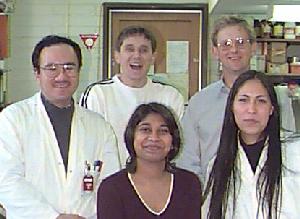

| Topics covered on this page are:
|
 |
"In a relatively stable habitat, variation between individuals of a population can mean that some have a better chance than others of surviving to maturity and producing offspring. If environmental conditions change or new habitats are invaded, some individuals in the population, through natural selection, may be better able to survive and reproduce than others. In both stable and changing environments the inherited characteristics possessed by better adapted individuals are likely to become more frequent in the population. Mutation, environmental factors and migration of groups of organisms into or out of populations, can each alter the degree of variation present in a population with consequent effects on evolution."p32, VCE Biology Study Design, © Board of Studies, 1993
The variations we see in the phenotypes of individuals of any single species can be quite spectacular. Look around a group of Homo sapiens and variation is evident immediately. Since we know that
Phenotype = Genotype + Environment |
we can conclude that the genotype, that is the DNA, of the individuals must be responsible for at least some of the variation we see.
In fact, if a number of individuals of a species have identical genotypes, usually as a result of their propagation by means of asexual reproduction, we observe that they also have identical phenotypes. Such organisms are often called clones.
However, if a number of clones, for example 20 identical azalea plants sold to 20 different people in a nursery, are subjected to different environments, the 20 different gardens to which they are taken home, they will surely display a variety of phenotypes in a number of years. Some of the plants will be growing vigorously and flowering brilliantly, some will be struggling, some will be covered with insect pests and some will be dead ... all from the same genotype! The environment has a profound influence on the variability of the phenotypes of genetically identical individuals!
Such simple observations as these demonstrate the biological basis of variation and lead us into the consequences of that variation - Natural Selection and Evolution.
If variations in organisms' phenotypes are to be explained in terms of variation in DNA composition, we need to consider how such variation between individuals could arise.
A mutation is a change in the DNA of an organism which may or may not have an effect on the genotype and phenotype. Normally, mutations are rare and random events, but under certain enivronmental conditions, this may not be true.
Since DNA is a complex molecule, there is a number of ways it can be altered. This has been described in more detail on the page of this site titled "New Proteins, Cells and Individuals".
Base-pair substitutions occur when one nucleotide and its partner from the other DNA strand are replaced with another pair. Since these substitutions only occur at one site on the DNA strand they are sometimes called point mutations. Point mutations often cause no effect at all (not all DNA codes for protein synthesis), but minor changes to proteins may occur (if one amino acid is altered but not in a way that changes the protein's function too much), and occasionally such mutations may be lethal (protein product absent or non-functional).
Mutations which involve insertion or deletion of segments of DNA into a chromosome are also known. If these involve lengths of DNA which are not a multiple of 3 bases, the triplet code of whole exons can be changed - these are then called frameshift mutations. Because long segments of DNA can be changed in this process, these are more likely to result in changes to protein products. Such changes are mostly for the worse, but at times an improvement to structure/function is the result.
It is often said thatIn order to understand why sexually reproducing species show much greater variation than asexually reproducing species, you need to review the details of sexual reproduction. Focus your attention on where the homologous chromosomes can go, and how not all the gametes from one parent are identical.
During meiosis, chromosomes replicate and become entwined. During this period, breaks in homologous chromosome pairs occur quite frequently. This is known as crossing over and when enzymes repair the breaks, recombination of the strands of DNA occurs, but not necessarily in the original form. In this way alleles can "swap" from one chromosome to another, sometimes with marked consequences to the offspring which inherits the new combination.
Even if crossing over and recombination did not occur, the fact that the homologous pairs of chromosomes (with their individual allele compositions) are randomly assorted into the gametes makes many different sets of genes possible in the gametes.
(An organism with a haploid number of 3 can be shown to produce 8 different combinations of gametes, the relationship is N = 2h , where N= no. of different gametes, h= haploid no. of the organism. For humans, with a haploid no. of 23, this means that there are 8 388 608 ways those chromosomes may be combined in a gamete!) (No, you do not have to remember this ... I just find the idea fascinating.)
The final way that chromosomes and their alleles become dispersed through a generation is in the process of fertilization, the union of two haploid gametes, from different parents, to form a new diploid individual.
(In the above example, the organism with haploid no. of 3 could produce 8 x 8 different combinations of offspring from one pair of parents. For humans, the number is (8 388 608)2 or approximately 7.03 x 1013! You don't have to remember this either. And we still haven't factored in crossing over or mutations!)
Once the gametes have united in fertilization, the diploid zygote begins the long process of repeated mitotic divisions, each one resulting in diploid cells of identical chromosome composition.
Eventually differentiation of the growing mass of cells occurs and tissues, organs and functioning systems develop. These are the somatic cells, all diploid, all containing the full compliment of genetic information, but differing in which particular genes are "switched on" in each cell type. A mutation in one of these cells may effect the functioning of that cell, and all those which form by mitosis from it. But unless the cell is a gamete producer, such effects cannot be passed on to future generations.
We already know that the environment can play a significant role in the phenotype of individuals. Nutritional requirements must be met, disease can alter phenotype and physical damage is always a threat to individuals. Other environmental factors can be shown to play a part in altering DNA, or in selecting for certain individuals.
As the population's exposure to the environment changes, some individuals will be better able to survive there than others of the same species. The reason for the difference in the ability to survive is in the genes of the individuals. But it is not until some factor in the environment reveals the survival advantage some individuals possess, that such a genetic difference becomes important. This is the basis of Natural Selection, about which there is more on another page.
Gradually varying phenotypes and genotypes of a species over a range of geographic locations are called clines. A species that varies with geographic location in this way is said to show clinal variation.
One of the most obvious examples of clinal variation is in the population of the species Homo sapiens. If we consider the many groups of humans in the world that we call 'races' this idea of clinal variation is well illustrated. Although we all belong to the same species, different environmental pressures have, over time, selected for different phenotypes (and different genotypes) in different geographical locations.

A number of physical and chemical agents in the environment, known collectively as mutagens, can interact with DNA to increase the frequency of mutation.
Some mutations have been shown to be temperature sensitive, that is, the altered protein functions normally at a certain range of temperatures, but not outside this range. If this type of mutation extends the range of tolerance of an organism, it could be of great benefit. In practice, such mutations generally reduce the tolerance limits of the protein and so are disadvantageous. With the current trend towards global warming due to the greenhouse effect, such temperature sensitive mutations may become important in the survival (or not) of some species.
Radiation, such as in X-rays and ultraviolet rays, may be increased in the environment due to human activity, but a constant natural source of such radiation is the sun, and this is undoubtedly the reason for some of the spontaneous mutations which occur with measurable frequencies.
Mutagenic chemicals can be the product of bacterial metabolism, viral activity inside cells, digestive processes or non-specific defence to foreign organisms. In recent times, human activity has added many new chemicals to this list.
As stated before, mutagens and the mutations they cause
can produce somatic changes in eukaryotes,
or
they can effect developing gametes.
The outcomes for evolution are vastly different!